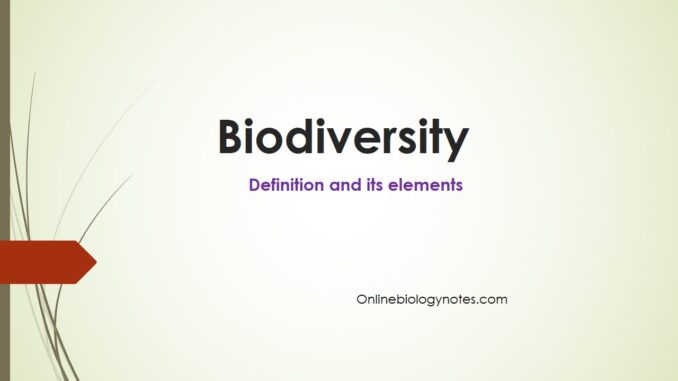
What is Biodiversity?
- Biodiversity is defined as the variations among living organisms from all possible sources. It includes the variability within or between the species and within or between ecosystems.
- According to the definition of the 1992 UN conference on Environment and Development (UNCED) Convention, biodiversity includes all of its manifestations. Therefore, along with terrestrial biodiversity, it also covers marine as well as other aquatic biodiversity. As such biodiversity means the richness and variety of living things in the world as a whole or in any location within it.
What are the elements of biodiversity?
- Major elements of biodiversity comprise of- Ecosystem diversity, Species diversity, and Genetic diversity.
1. Ecosystem diversity
- An ecosystem is made of a dynamic system of plant, animal, and microorganism groups and their non-living environment altogether interact as functional unit.
- Non-living components cover sunlight, air, water, minerals and nutrients.
- Ecosystem can be small and short-lived, for example, water filled tree holes or rotting logs on a forest floor or large and long-lived like forests or lakes. Thus, ecosystem commonly exist within ecosystems.
- Ecosystem diversity refers to the variation and rate of occurrence of distinct ecosystems including the variety of habitats, biotic communities and their change in structure and composition over time and ecological processes in the biosphere.
2. Species diversity
- Species is defined as a population of organisms whose members are able to interbreed freely under natural conditions.
- A species represents a group of organisms which has evolved definite inheritable features and occupies a unique geographical area.
- Species usually do not freely interbreed with other species (Wilson,1992).
- Species diversity is used to describe the frequency and variety of species (wild or domesticated) within a geographical area.
- The total number of species in the globe has been estimated to range from 5-30 million (Wilson,1988), out of which approximately 1.7 million living species of all kinds of organisms have been described to date (WCMC,1992).
- The World Conservation and Monitoring Center suggests that there are many different ways to describe species diversity:
- Species richness is the total number of species within a geographical area.
- It is expressed as an enumeration of the species occurring within a particular sample area, and is one often used to measure species diversity.
- Measures of species richness are the basis for the observation that diversity increases with decreasing latitude on Earth, for example, tropical areas are richer in species than temperate areas.
- Species evenness is also used to measure species diversity which is expressed as relationship of species to each other.
- This includes relative abundance of species in different categories.
- It is also known as taxonomic diversity. For example, an island with two species of birds and one species of lizard has greater taxonomic diversity than an island with three species of birds but no lizards (Raven,1992).
- Species dominance is expressed as the most abundant species as dominant (Botkin and keller,1995).
3. Genetic diversity
- Genes are the principal units of heredity which are passed from an organism to its offspring.
- These are composed of nucleic acids and are located along an organism’s chromosomes, in the plasmids of bacteria and other extra-chromosomal forms as well.
- Genes, either individually or in groups contribute different credits to an organism such as its physical appearance (black eyes or dark hair), its ability to resist certain pests, or survive drought
- Genetic diversity refers to contrast of genes and/or genomes within living organisms, that is, the genetic differences among populations of a single species and among individuals within a population.
- In other word this covers distinct populations of the same species such as hundreds of traditional rice varieties in Nepal.
- According to Raven (1992), it is also expressed as genetic variation within a population, such as genetic variation is very high among Indian rhinos, and very low among Cheetahs.
- Nature’s wild species contain valuable genetic information.
- If a species is to survive, it needs some genetic diversity. But an inbred population loses diversity, and becomes vulnerable to pests and infectious diseases which may endanger the whole population.
- Using ‘DNA fingerprinting’, molecular biologists can detect inbred population which may be moving forward for extinction.
- In the agriculture industry, monoculture crops, artificial insemination and embryo cloning technique lead to narrow, inbred population. In biomedicine too, genes from such species as fungi, lichens, marine organisms and higher plants have been used to produce antibiotics, anti-cancer agents, hormones, muscles relaxants, cardiac and respiratory stimulants.
- Modern biotechnology is generating recombinant DNA vaccines and pharmaceuticals, gene probes for inherited disease and forensic analysis, and genetically engineered organisms for mining, energy, chemical production and treatment of waste products.
- Therefore, genetic heritage of the earth once preserved can be read, appreciated and perhaps even reactivated by future generations.
References:
- Chaudhary Ram P., M.Sc., Ph.D., D.Sc., F.N.R.S., Professor of Botany, TU, Kirtipur, Ktm, Nepal, Biodiversity in Nepal,1998.
- www.biologicaldiversity/org
- www.yourarticlelibrary.com
